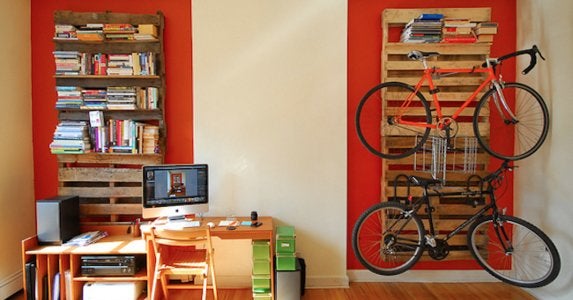How To: Soundproof a Wall
No more noise pollution! Enjoy the sounds of silence with these easy techniques.
Whether your teen has rock star dreams or your 8-year-old has started tap-dancing, you’ll find that a little soundproofing can go a long way toward keeping the peace—and quiet—at home. Soundproofing is most effective when done during construction, but there are several ways toput a damper on ambient and active noiseafter the fact. In terms of décor, cumulative use ofrugs, textiles, and cloth wall panels can all help reduce the din. To minimize more serious noise, consider the two strategies for how to soundproof a wall outlined here.
Method #1: How to Soundproof a Wall with Mass-Loaded Vinyl
Mass-loaded vinyl (MLV) is a sound-dampening product used everywhere from nightclubs to recording studios to hockey rinks. It comes on a roll and is available online for around $2 per square foot, depending on weight, length, and width. The thicker the better for blocking noise and ending echoes, but thickness, ranging from 1/16 inch to ¼ inch, may not be listed in product specifications. If not, you’ll see a weight instead. Half-pound MLV weighs one-half pound per square foot of coverage, and is 1/16-inch thick; one-pound MLV is a pound per square foot of coverage and is 1/8-inch thick; two-pound MLV is ¼-inch thick.
While MLV can be hung directly on awall, it performs best when sandwiched between sheets of drywall. Doing so also allows you aesthetic options, since the usually black, shiny MLV isn’t the most decoratively appealing surface! And keep in mind that MLV is heavy and awkward to work with—hanging it is a two-person job, so enlist a helper.
MATERIALS AND TOOLSAvailable on Amazon
–Measuring tape
–Massloadedvinyl
–Heavyduty scissors or utility knife
–Stepladder
–Drywall nails
–Hammer
STEP 1
Prior to ordering MLV, carefully measure the walls you want to soundproof. Leaving gaps in MLV will drastically compromise its effectiveness, so you’ll want to buy enough for complete coverage from wall to wall andfloorto ceiling. When calculating your needs, note that MLV tends to be sold on rolls of 2-foot or 4-foot widths.
STEP 2
Measure a length of MLV that will reach floor to ceiling and then cut out a sheet with the scissors or utility knife. Cutting on top ofscrap woodwould be wise to protect your floor or work surface.
STEP 3
Position the stepladder and put the MLV against the wall starting at either end, working to the other corner. To install it, snug it up against theceiling, with your helper holding it in place. Using drywall nails and a hammer, attach the MLV to the upper portion of the wall at 12-inch intervals. Then attach the bottom portion at 12-inch intervals, and finally at 12- to 24-inch intervals down the sides of the sheet.
STEP 4
Repeat Steps 2 and 3 as required until the entire wall is covered. Be sure to butt the MLV right up against the preceding sheet so there are no gaps. Feel free to overlap it for a potentially greater sound barrier, but you’ll have bumps and ridges if you do so.
STEP 5
Install a layer ofdrywallon top the MLV to make the soundproofing twice as effective and give you a surface for paint or other wall covering décor (go here for a how-to). Or read on for a quick solution to hiding the glossy black vinyl with curtains—a no-commitment décor project that will also enhance soundproofing.
Method #2: How to Soundproof a Wall with Curtains
Not for windows only, curtains can create drama on the walls of any room while offering considerable soundproofing benefits. They’re relatively inexpensive and as easy to remove as they are to install. While there arecurtainsspecifically marketed as sound dampening or “acoustic,” blackout and thermal curtains, primarily sold to keep light out and warmth in, also offer noise reduction. Don’t let the term “blackout” fool you: These curtains come in many colors and styles—it’s the inner liner that provides the blackout/thermal effect. Even heavy fabrics like velvet provide some soundproofing.
Keep in mind that when you double the weight of the fabric, you up to triple its sound-reduction ability. Yet more important than weight is curtain construction: Pleated curtains can be three times as effective against noise as those that hang straight because the pleats not only doublefabricthickness in many parts, but also act like a baffle, confounding a sound wave’s reflection and stopping it in the fabric folds.
Remember, sound dampening is the goal, so a floor-to-ceiling curtain that covers the entire wall will have the most impact. You can purchase curtains in multiple panels to fill the wall. If feeling adventurous, mix colors and patterns for a funky feature wall!

Photo: istockphoto.com
MATERIALS AND TOOLSAvailable on Amazon
–Measuring tape
– Heavy curtains, preferably ceiling-to-floor length
——体重秤
– Hanging system (rods, wires, or other systems rated for your curtain weight)
——螺丝刀或钻
– Screws
– Stud finder (optional)
– Weight-rated wall anchors (optional)
– Iron or steamer
STEP 1
Measure the wall prior to purchasing curtains. When shopping, check package info for the curtains’ weight; you’ll need this to choose rods or another hanging system sturdy enough to hold them. If you’re set on curtains that don’t include the weight on the packaging, weigh them on yourbathroomscale at home. Tip: Keep them in the package so they’ll sit easily on the scale.
STEP 2
Purchase a hanging system weight-rated for the curtains (packaging or website marketing should tell you the weight load they can handle). If they weigh 40 pounds and the wall to be covered is 12 feet long, you’ll need a rod or hanging system that can handle roughly 3.5 pounds per foot, so keep that weight rating in mind when making your choice.
STEP 3
Before mounting the hanging system, ensure enough space above it for the top of the curtains to move freely without bunching against the ceiling—a half-inch or inch should do. Locate wall studs with a stud finder, or use proper weight-rated wall anchors, before boring into the wall withscrews. Affix the rod or hanging system to the walls as recommended by the manufacturer. Check out these helpful articles to guide you through stud-finding and curtain-hanging in detail:
Three Ways to Find a Wall Stud (Without Fancy Equipment)
How To: Install Curtain Rods
STEP 4
Iron or steam curtains to remove creases and wrinkles from the packaging. Check the labels to see what temperature the manufacturers suggest and iron accordingly.
STEP 5
Hang the curtains on the rod or wire system and then “bunch” them together in equal amounts across the entirewall一个一致的外观。请记住,褶皱,bunched fabric will absorb more sound than flat, so ample curtains are a plus.









